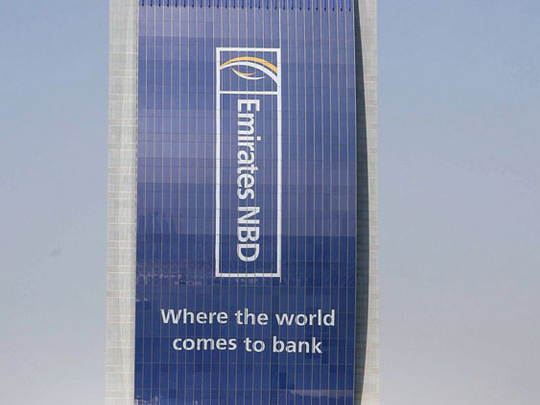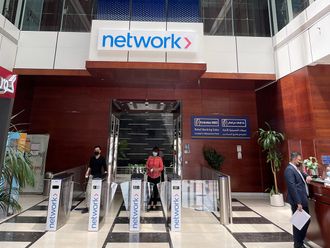
Dubai: Most UAE banks have reported first quarter profits surpassing the market expectations.
However, bankers and analysts were cautious about expectations for the next three quarters as a potential rise in bad loans, sluggish loan growth and high funding costs were expected to curtail their full-year performance.
The UAE's leading banks in terms of assets such as the Emirates NBD and National Bank of Abu Dhabi (NBAD) reported first quarter profits far exceeding analysts' expectations.
While NBAD reported a 34 per cent increase in the first-quarter net profit, Emirates NBD and ADCB had to be content with 12 per cent and 34 per cent decline in profit respectively on a year-on-year basis.
Analysts said the first quarter results were indeed encouraging, but it was too early to jump to conclusions as the fourth quarter tended to be the most feared since banks chose to lump in there all items that had not been provided for in the preceding quarters.
Last year the total provisions of the UAE banks up to the close of the third quarter was Dh3.2 billion and the same shot up to more than Dh7 billion in the fourth quarter.
This could be because the fourth quarter tended to be the last quarter where audited accounts for the full year have to be presented.
"It will be naïve to equalise the importance of all the quarters. I believe the first three quarters can be somewhat quiet in terms of loan loss provisions, while the fourth quarter will normally take the largest hit," said M.R. Raghu, Senior Vice President-Research, Kuwait Financial Centre (Markaz).
In absolute terms, total provisions for the first quarter of 2010 added up to $1.5 billion, which was 239 per cent higher than in the first quarter of 2009.
"If this is the trend, then we haven't seen the peak yet," he said.
NBAD said it saw bad loans rising for at least the next two quarters, its chief executive Michael Tomalin said earlier this month.
Analysts agreed. "Banks usually postpone sizeable provisions to the fourth quarter — a trend we have seen for the last two years," said Deepak Tolani, an analyst with Al Mal Capital.
"With the Dubai World issues on the table and potential for other restructuring from Dubai Holdings, banks could face sizeable (but manageable) write-downs."
Despite the consensus on an increase in NPL ratios in 2010 and 2011, analysts expected asset quality of Abu Dhabi banks to improve over the next year.
National Bank of Abu Dhabi's asset quality was the best with a first-quarter non-performing loan (NPL) ratio of 1.33 per cent.
"We estimate the average NPL ratio of (Abu Dhabi) banks to increase from 2.4 per cent in 2009 to 3.6 per cent in 2011," said Mohammad Hawa, an analyst with Credit Suisse.
However, with the high exposure of Dubai banks to Dubai World and other corporate debts, analysts said they feared the asset quality of some banks would adversely affect their lending capability.
Janany Vamadeva, a banking analyst with H C Securities said: "We expect loan growth to be soft during the course of the year due to the cautious approach taken by banks amid deteriorating asset quality and liquidity issues".
"Banks still face issues as seen in the increase in interbank rates," she said. Banks agreed that the loan growth would continue to be under pressure.
After NBAD announced its first quarter results Tomalin said: "Loan growth for 2010 will be subdued" due to central bank policy and "liquidity tightness".
Overall bank lending in the UAE was likely to rise between five per cent and 10 per cent this year and NBAD's own loan growth would be "within the systemic level," he said.
Emirates NBD said it expected its non-performing loans to peak at about three per cent, Chief Financial Officer Sanjay Uppal said after the bank released its results.
"The bank expects only loan growth of mid-single digits this year," Uppal said.
While rising NPLs, liquidity issues and higher cost of funding were likely to limit the lending capacity of banks, the conservative loans-to-deposit ratio of 100 per cent prescribed by the UAE Central Bank was also expected to affect the banks' lending capacity.
UAE Central Bank governor Sultan Bin Nasser Al Suwaidi told the Oxford Business Group (OBG) recently that although the Central Bank had issued timely advice urging banks to weigh up the risk element when giving loans, he had no major concerns that this advice could lead to the sector becoming too cautious.
The Central Bank governor acknowledged that the conservative labelling of loan-to-deposit ratios adopted by the UAE banking system belied the real strength which characterised the sector.
"Nobody else in the world would label deposits like we do," he said.
"If you compare the UAE to other jurisdictions, you will find the definition is extremely conservative, very solid."
The Central Bank guideline has pushed the banks to improve their loan-to-deposit ratios.
Emirates NBD saw its loan-to-deposit ratio improve to 111 per cent in the first quarter from 118 per cent at end-2009 while First Gulf Bank's (FGB) saw an improvement from 105 per cent at the end of 2009 to 104 per cent, while Abu Dhabi Commercial Bank (ADCB) recorded an improvement in this ratio from 135 per cent at the end of last year to 130 per cent at the end of first quarter 2010.
First-quarter results showed that the loan books of most banks had reported marginal growth.
As banks restricted their lending, the gap between loans and deposits was expected to narrow this year.
The Central Bank governor said the conservative labelling of loan-to-deposit ratios adopted by the UAE banking system had improved the balance sheet strength of banks.
"Nobody else in the world would label deposits like we do," the governor said.
"If you compare the UAE to other jurisdictions, you will find the definition is extremely conservative, very solid. It doesn't initially reveal the strength that is inherent in it."
Analysts said in addition to a conscious deleveraging by banks, demand-side slowdown was also affecting the slow loan growth in the country. "It is a combination of both but more due to deleveraging. The process (of deleveraging) can last two to three and ‘til that time we will see muted loan growth," said Markaz's Raghu.
On the liability side of the balance sheet, banks had been facing sluggish deposit growth which is expected to push many of them to seek funding through debt capital markets.
"We expect banks to tap the debt markets once the conditions are more favourable and conducive. However timing depends on when the debt issues are sorted out and also the international markets," said HC Brokerage's Vamadeva.
Results similar across all banks
Dubai: The first quarter results of leading UAE Islamic banks was similar to that of conventional banks on non-performing assets, lending and deposit growth.
The only notable exception was Abu Dhabi Islamic Bank (ADIB) that reported first quarter profit of Dh293 million — almost four times the profit figure achieved for all of 2009.
Non-performing loans (NPL) had forced the bank to set aside Dh1.3 billion in provisions last year, of which Dh1 billion came in the fourth quarter.
"The results are pretty much in line with our expectations with the exception of provisions," said HC Securities banking analyst Germaine Benyamin.
The bank's financing activity grew by five per cent to Dh43.8 billion and its deposits by four per cent to Dh49.9 billion.
However Dubai Islamic Bank's (DIB) first quarter net profit plunged 46 per cent, hit by rising loan provisions and lower contribution from group companies. The bank reported a net profit of $54.47 million in the three months with $100.8 million in the same period in 2009.
First quarter profits sharply missed analysts' expectations.
DIB's assets grew modestly to $23.1 billion at end March, from $22.9 billion at the end of 2009. Customer deposits stayed steady at $17.6 billion from $17.4 billion at the end of last year. The bank reported a financing-to-deposit ratio of 79 per cent.
Sharjah Islamic Bank's net profits for the first quarter of 2010 fell by 20 per cent Dh67.5 million compared to Dh85 million the same period last year. Total assets stood at Dh16.2 billion compared to Dh16 billion at the end of last year.
Emirates Islamic Bank reported an increase (1.2 per cent) in net profits from Dh65.77 to Dh66.62 million.










